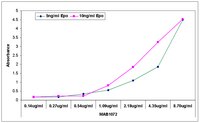MAB1072 Sigma-AldrichAnti-Erythropoietin Antibody, clone 1C8
Detect Erythropoietin using this Anti-Erythropoietin Antibody, clone 1C8 validated for use in ELISA, IF & WB.
More>> Detect Erythropoietin using this Anti-Erythropoietin Antibody, clone 1C8 validated for use in ELISA, IF & WB. Less<<Recommended Products
Overview
| Replacement Information |
|---|
Key Spec Table
| Species Reactivity | Key Applications | Host | Format | Antibody Type |
|---|---|---|---|---|
| H | ELISA, IF, WB | M | Purified | Monoclonal Antibody |
| References |
|---|
| Product Information | |
|---|---|
| Format | Purified |
| Control |
|
| Presentation | Purified mouse monoclonal IgG2b in buffer containing 20 mM sodium phosphate, 300 mM NaCl, and 0.02% sodium merthiolate. |
| Quality Level | MQ100 |
| Physicochemical Information |
|---|
| Dimensions |
|---|
| Materials Information |
|---|
| Toxicological Information |
|---|
| Safety Information according to GHS |
|---|
| Safety Information |
|---|
| Storage and Shipping Information | |
|---|---|
| Storage Conditions | Stable for 1 year at 2-8ºC from date of receipt. |
| Packaging Information | |
|---|---|
| Material Size | 250 µg |
| Transport Information |
|---|
| Supplemental Information |
|---|
| Specifications |
|---|
| Global Trade Item Number | |
|---|---|
| Catalogue Number | GTIN |
| MAB1072 | 04053252266386 |
Documentation
Anti-Erythropoietin Antibody, clone 1C8 SDS
| Title |
|---|
Anti-Erythropoietin Antibody, clone 1C8 Certificates of Analysis
| Title | Lot Number |
|---|---|
| Anti-Erythropoietin, clone 1C8 - 2121751 | 2121751 |
| Anti-Erythropoietin, clone 1C8 - 2148240 | 2148240 |
| Anti-Erythropoietin, clone 1C8 - 2111385 | 2111385 |
| Anti-Erythropoietin, clone 1C8 - 2197223 | 2197223 |
| Anti-Erythropoietin, clone 1C8 - 2327716 | 2327716 |
| Anti-Erythropoietin, clone 1C8 - 2330589 | 2330589 |
| Anti-Erythropoietin, clone 1C8 - 3184765 | 3184765 |
| Anti-Erythropoietin, clone 1C8 - 3207103 | 3207103 |
| Anti-Erythropoietin, clone 1C8 - 4082572 | 4082572 |
| Anti-Erythropoietin, clone 1C8 - LV1514199 | LV1514199 |










